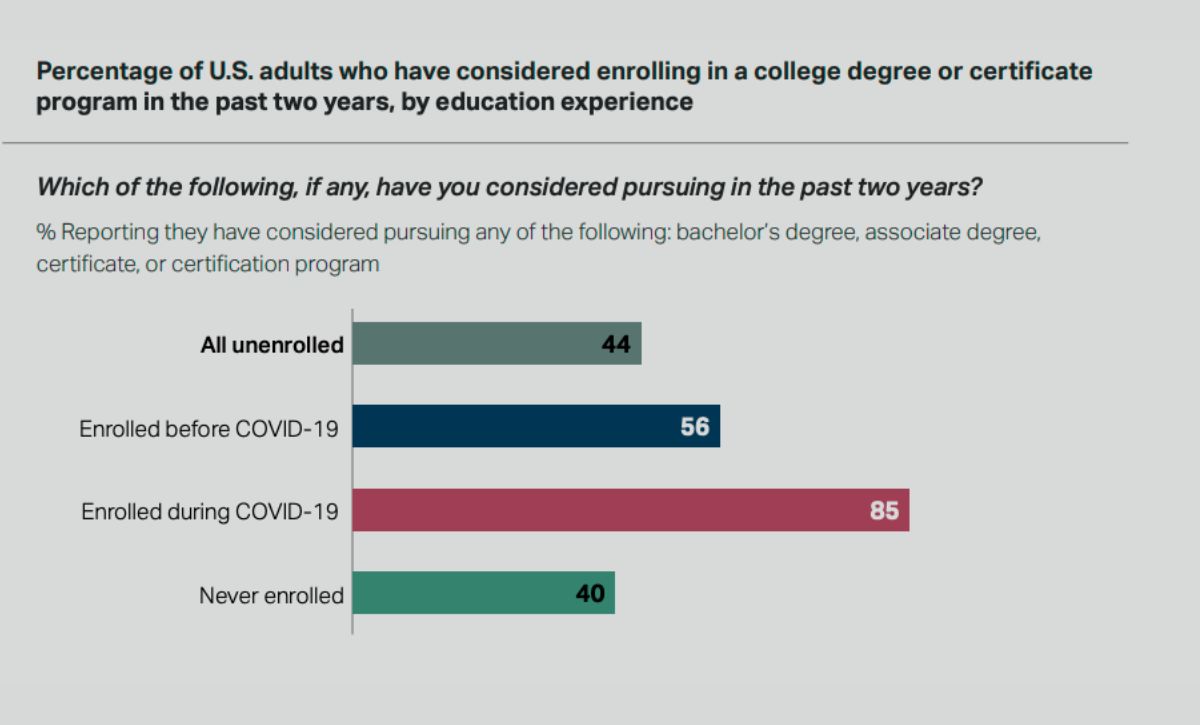Most Students Who Left College During COVID Want to Return — But Many Can’t
Brown: Money, stress and family & work obligations are keeping students from returning to college and earning their degrees, survey finds

Get stories like these delivered straight to your inbox. Sign up for The 74 Newsletter
Enrollment in colleges and universities continued its steep plunge this spring, down 4.7% from a year ago. The nation’s higher education drop is worsening — but not for the reasons you might think.
A newly released National Student Clearinghouse report shows total post-high school enrollment fell by about 685,000 students in spring 2022. In the wake of COVID-19 losses and disruptions, U.S. colleges and universities have lost 1.3 million students over the past two years.
In a world where higher education is crucial to good jobs and better lives, too many Americans are being left behind. But media reports suggesting students no longer value a college degree are wrong. In fact, our recent Gallup-Lumina Foundation study shows the opposite: There is high demand and interest in higher education. But many can neither access nor afford it.
The survey found that 85% of students who left college during the pandemic say they want to return to school. Over half, 56%, of those who were enrolled before the pandemic are considering going back. And 40% of those who never went to college say they want to enroll.
Students told Gallup the reasons they aren’t enrolling or staying in school are that they’re worried about the cost, have tremendous stress, feel unprepared academically and struggle with heavy family and work obligations. It is probably not a surprise that the expense of college is the top factor cited by people not currently in school (59% of those enrolled before COVID, 52% who were enrolled during the pandemic and 54% of those who never enrolled). Family responsibilities were cited by one-third, work conflicts by about one- quarter. An overwhelming 76% of bachelor’s degree students and 63% of associate degree students point to stress as the main reason they may leave college. Students are twice as likely to cite stress over other concerns, including COVID-19 (33%), cost (36%/3%) or difficult coursework (34%/24%).
Only 16% of those who left college during the pandemic and 20% of those who never enrolled say the reason is that additional education lacks value. In other words, most students believe college is worth it, but money and stress hold them back.
Turning this tide means accelerating change, transforming policies and practices to serve the urgent needs of students who are older and more diverse than in years past and are often stretched thin on time, money and support. Nearly 49% pay their own bills, 24% are raising children and more than 64% work, 40% of them full time.
Community colleges continue to suffer the most, with a total loss of well over 800,000 students since spring 2020. Most concerning are the data showing dramatically lower numbers of Hispanic and Black students in community college programs. Black enrollment is down nearly 25% at two-year colleges since the start of the pandemic, and Hispanic enrollment fell nearly 15%. The nation isn’t close to bridging the equity gaps that are the key to our collective prosperity. This is troubling news.
It is clear Americans value higher education as an important step in finding an ideal job and building a brighter future. To make that a reality not just for current students or the 1.3 million lost since 2019, but also for the millions who never considered enrolling, it is essential to accelerate change and eliminate barriers by focusing on finances, comprehensive student support, and mental and emotional health.
- Cost. Schools must find ways to make college affordable and better communicate financial aid packages to students, because money is the No. 1 reason they enroll or stay in school. It is also essential that colleges eliminate fees and punitive policies that hold transcripts or enrollment hostage over unpaid parking tickets or other small fees.
- Comprehensive student support. Young people face family and work obligations that often make higher education difficult or impossible. To help them, schools must invest in ways to support them with help ranging from child care and food banks to virtual advising and emergency aid. In addition, institutions must offer clear career pathways to better inform individuals about what opportunities their degree will offer.
- Counseling. Amid a rash of heartbreaking suicides on campus, suicide now is the second-leading cause of death for young people ages 10 to 24. Students must have easy access to affordable mental health care through online and real-time therapists and emergency hotlines.
By understanding today’s students — and closely following the data — the nation can help millions of Americans improve their lives through the power of learning.
Get stories like these delivered straight to your inbox. Sign up for The 74 Newsletter

;)